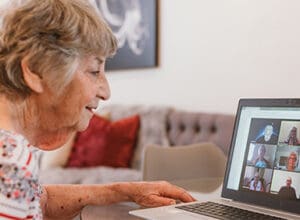May 26, 2021
Front Porch and Covia Residents Build Communities of Strength
May is Older Americans Month, and this year’s theme is Communities of Strength. But what makes a community strong?
“It starts with connection,” says Ellin Ostler, a resident at Vista del Monte in Santa Barbara. “I believe that connecting with people, even during COVID, is extremely important,” Ellin says. “I met with several people each day, even if it was over the phone or through Zoom.”
As many of us learned this past year, connections do not have to be face-to-face to be meaningful. Well Connected, a Community Services program that offers phone and online activities such as group conversations, games, and education, has proven to be highly effective at building community. “The Well Connected community offers a sense of connection and belonging through volunteers who are committed, reliable and friendly,” says Jill Melchior, a Well Connected participant from California. “This has really made a difference in the lives of many, especially, during the pandemic when so many of us felt isolated.”
For those who decide to move to a physical community the sense of connection begins on day one. “We have residents who go far out of their way to welcome and integrate new residents,” says Joyce B. Friedman of San Francisco Towers. Retired kindergarten teacher Pat Ganje who lives at Villa Gardens in Pasadena says, “Because we have so many educators here from college down to early grades, those experiences have built much of our culture. We are used to welcoming people and being involved. So when someone new moves in, we find ways to get them involved, too.”
Adele Pickar found that same sense of hospitality when she moved to Spring Lake Village in Santa Rosa. “I noticed immediately the friendliness of the residents and staff,” she says. “Everyone smiled and said hello. It was a heartwarming welcome for me into this community. A culture of friendliness; nothing could be better in my book of beginnings.”
Adele explains that a strong community needs to be built on trust and mutual respect. “Many times, people wait for an opening to know you better and then begin to build a relationship of trust,” she says. “I believe these personal attributes make our community a very strong one. I also believe that these traits contribute to resilience, which we surely need and enjoy as we age.”
Welcoming new residents is just the first step. “At Spring Lake Village, the variety of ways to get to know each other and find common interests and new stimuli is terrific,” says resident Susan Drake. Beyond finding common interests, residents support one another. Susan recalled that when one resident had a serious health issue, an email list of 37 of her friends was set up to convey messages to her son about her progress.

Communities of strength find ways to help people through life’s changes as well. In 2014, members of the resident-led Spring Lake Village Wellness Committee began The Transitions Program in an effort to address the emotional, social and spiritual needs of residents. “Life experiences such as moving to our community, changes in our physical abilities, loss of partners, family members and friends, crisis events such as fire and attendant evacuation, have been addressed through the Transitions Program,” says program leader Janet Gelfman. “In providing an opportunity for residents to listen to, and to share their life experiences in honest conversation, Transitions makes our community stronger and more resilient to the effects of aging.”
Communities of strength also reach out beyond themselves to help others. Ellin shared how Vista del Monte hosted a “Turkey Trot” at Thanksgiving and “Bunny Hop” during Easter time. “We walked and we contributed to the food bank,” Ellin says. “On the Bunny Hop, we raised $3,725. I think the creativity and the willingness of our residents to get involved is really one of the strengths of our community.”
Spring Lake Village also extends its mission beyond its physical walls with a very active Community Outreach Committee, which has raised money for a wide range of local agencies. Members of the Community Outreach Committee explained how, along with Habitat for Humanity, the committee built a playhouse for a little girl whose family lost their home in one of the California fires of 2017.
For Pat Ganje, Camp Villa, a summer camp for local children organized by Villa Gardens residents and hosted at their community was a great way to engage both residents and neighborhood kids. “All my fellow residents wanted to volunteer, so our challenge was unusual. We had more volunteers than jobs!”
“The best part of the experience was the mutual benefit,” Pat says. “We received as much, or more than, we gave.”
“Community that is created here, is genuine,” says Frank Marini, a resident of Fredericka Manor in Chula Vista. “The residents are very important, but it’s never been clearer to me than this past year that the staff here are a big part of this community.”
At San Francisco Towers, “We are blessed with an outstanding staff, who are helpful, kind, and supportive,” Joyce says. Susan from Spring Lake Village adds, “Staff goes the extra mile to make residents feel safe. Words aren’t enough to convey this appreciation.”
“Our strength has been expressed throughout the COVID isolation with residents finding ways to bolster one another’s spirits and to appreciate the incredible efforts of our management and employees to provide a safe and nourishing time,” says Janet of Spring Lake Village. “As we ‘open up’, we will once again be able to join together to share our stories, gaining strength and healing from one another.”









